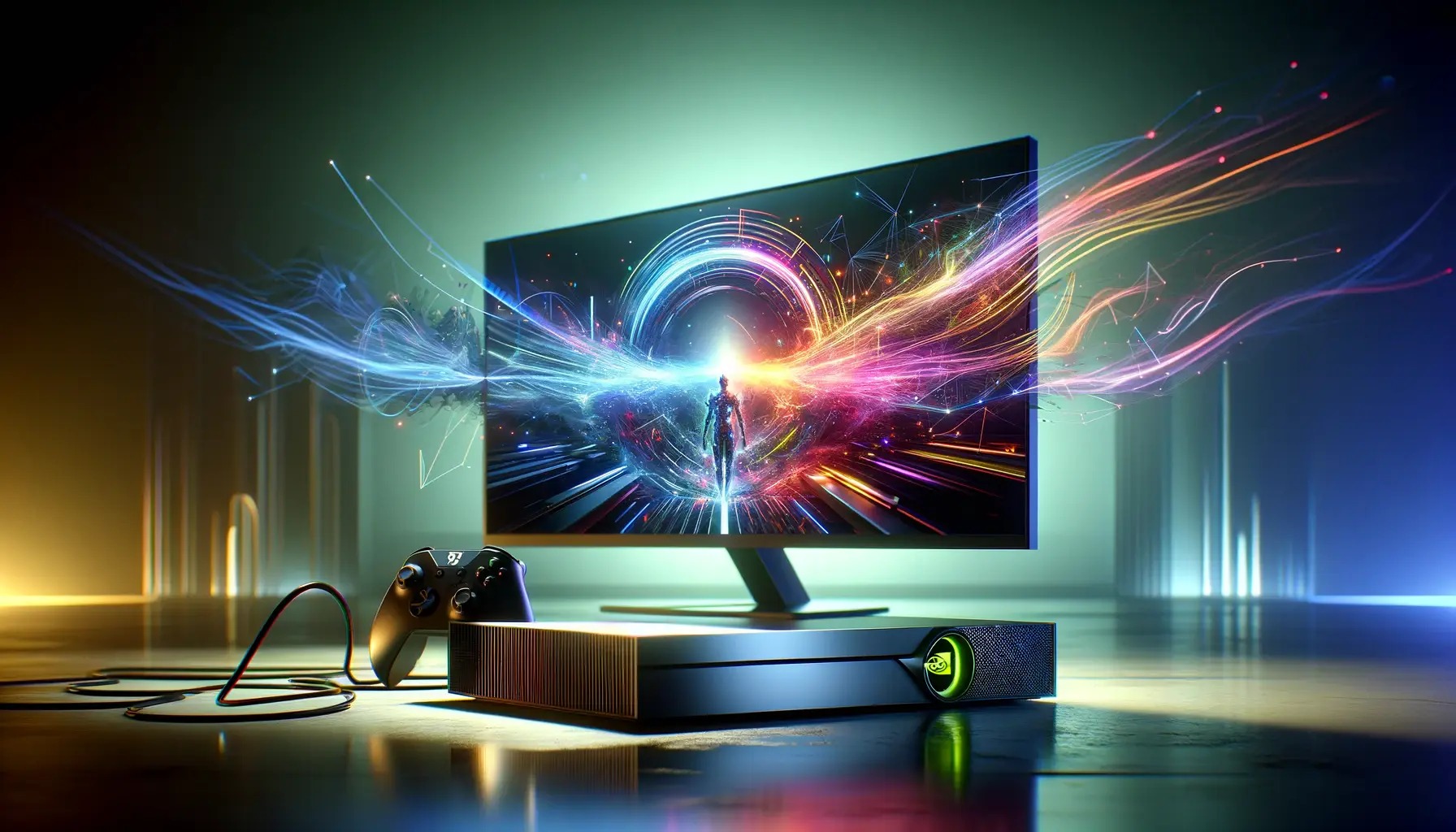Gaming technology is constantly evolving, pushing the boundaries of what’s possible in virtual worlds.
Among the innovations leading this charge, NVIDIA’s Deep Learning Super Sampling (DLSS) technology stands out, particularly its latest iteration, DLSS 3.
This groundbreaking feature is not just an incremental update but a significant leap forward in gaming performance and visual fidelity.
By leveraging advanced AI and machine learning algorithms, DLSS 3 promises to redefine the gaming experience for players and developers alike.
At its core, DLSS 3 is designed to address one of the most challenging aspects of modern gaming: delivering high-resolution, high-fidelity graphics without compromising on frame rates.
This balance is crucial for immersive gaming, especially in fast-paced titles where every millisecond counts.
NVIDIA’s solution harnesses the power of AI to intelligently upscale images, enabling gamers to enjoy stunning visuals at higher frame rates than would be possible with traditional rendering techniques.
- Understanding DLSS Technology
- The Impact of DLSS 3 on Gaming Performance
- DLSS 3 in Action: Real-World Applications
- Comparing DLSS 3 with Other Upscaling Technologies
- Optimizing Gaming Setups with DLSS 3
- Future of Gaming with DLSS 3
- Challenges and Considerations for DLSS 3 Adoption
- Embracing the Future with DLSS 3
- DLSS 3 Frequently Asked Questions
Understanding DLSS Technology
Before diving into the specifics of DLSS 3, it’s essential to understand the foundation of DLSS technology.
Deep Learning Super Sampling utilizes neural networks to analyze millions of images and learn how to efficiently upscale lower-resolution images to higher resolutions without losing detail.
This process significantly reduces the computational load on the GPU, allowing for smoother gameplay and higher frame rates.
DLSS also incorporates anti-aliasing techniques to reduce visual artifacts, making the gaming experience more visually appealing.
DLSS technology has evolved over time, with each version bringing improvements in performance, image quality, and compatibility.
DLSS 3, however, represents a quantum leap forward.
It introduces several new features, including frame generation and Reflex, which work together to dramatically enhance gaming performance.
By generating intermediate frames and optimizing system latency, DLSS 3 allows games to run at incredibly high frame rates, making every movement and action feel more responsive and fluid.
Frame Generation: A Game Changer
The introduction of frame generation in DLSS 3 is a game-changer for the gaming industry.
This feature uses AI to create additional frames between existing ones, effectively doubling the perceived frame rate.
For gamers, this means smoother animations and a more immersive gaming experience, especially in fast-paced titles where precision and reaction time are critical.
Frame generation also helps to mitigate the impact of performance drops, ensuring a consistent and enjoyable gaming experience even in graphically demanding scenes.
However, frame generation is not just about boosting frame rates.
It also contributes to a significant reduction in perceived latency.
By generating frames that predict subsequent in-game actions, DLSS 3 minimizes the delay between a player’s input and the corresponding action on the screen.
This improvement in responsiveness is a boon for competitive gamers, for whom every millisecond can make the difference between victory and defeat.
DLSS 3’s frame generation technology represents a significant advancement in gaming performance, offering smoother gameplay and reduced latency, which are crucial for a superior gaming experience.
The Impact of DLSS 3 on Gaming Performance
The advent of DLSS 3 has brought about a transformative change in the realm of PC gaming, particularly in how games are rendered and experienced on screen.
This section delves into the tangible benefits DLSS 3 offers to gamers, highlighting its profound impact on gaming performance and visual quality.
DLSS 3 achieves a remarkable balance between high-resolution graphics and fluid gameplay, a feat that has long been challenging for even the most advanced gaming rigs.
By intelligently upscaling images and generating additional frames, DLSS 3 ensures that gamers no longer have to choose between visual fidelity and performance.
The result is a seamless gaming experience that was previously unattainable with traditional rendering techniques.
Enhanced Frame Rates and Smooth Gameplay
- Increased Frame Rates: DLSS 3 significantly boosts frame rates by generating additional frames and upscaling images. This leads to smoother animations and gameplay, particularly in fast-paced and action-packed titles.
- Reduced Latency: By optimizing system latency, DLSS 3 ensures that the time between a player’s input and the game’s response is minimized, enhancing the overall responsiveness of the game.
Visual Quality Improvements
- Higher Resolution with Lower Performance Cost: DLSS 3 allows games to be rendered at lower resolutions and then upscaled to higher resolutions without the usual performance penalty, maintaining crisp and clear visuals.
- Improved Anti-Aliasing: The technology incorporates advanced anti-aliasing techniques to reduce visual artifacts, resulting in smoother edges and more realistic textures.
Compatibility and Accessibility
- Wider Game Support: NVIDIA continuously works with developers to integrate DLSS 3 into a broad range of games, expanding its benefits to more titles and genres.
- Accessibility for Various Hardware: While DLSS 3 is optimized for the latest NVIDIA RTX series, its underlying principles and some features are being adapted to improve performance across a wider range of hardware configurations.
The impact of DLSS 3 extends beyond just improved frame rates and visual quality; it also enhances the accessibility of high-quality gaming experiences across a variety of hardware configurations.
DLSS 3 in Action: Real-World Applications
The theoretical advantages of DLSS 3 are compelling, but its real-world applications in gaming provide concrete evidence of its transformative impact.
Through a combination of AI-driven techniques, DLSS 3 has redefined what gamers can expect from their hardware, pushing the boundaries of performance and visual fidelity.
This section explores how DLSS 3 has been implemented in various games and the tangible benefits it has brought to the gaming community.
From blockbuster titles to indie gems, DLSS 3 has been integrated into a wide range of games, each benefiting from smoother frame rates, enhanced visuals, and reduced latency.
The technology’s versatility and adaptability have made it a crucial tool for developers looking to optimize their games for the diverse landscape of PC hardware.
Case Studies: DLSS 3 Enhanced Games
- Cyberpunk 2077: A prime example of DLSS 3’s impact, Cyberpunk 2077 saw dramatic improvements in both performance and visual quality. Frame rates nearly doubled in 4K resolution, while the game’s rich, detailed world became even more immersive thanks to DLSS 3’s upscaling and frame generation.
- Fortnite: In Fortnite, DLSS 3 helped maintain high frame rates during intense battles and large-scale constructions, ensuring smooth gameplay without sacrificing the game’s vibrant visuals.
- Control: For a game renowned for its stunning ray-traced effects, DLSS 3 was instrumental in allowing gamers to experience Control’s visually rich environment without performance hitches, even at higher resolutions.
Feedback from the Gaming Community
The gaming community’s response to DLSS 3 has been overwhelmingly positive, with many players citing the technology as a game-changer for PC gaming.
Gamers have noted significant improvements in gameplay smoothness and visual quality, particularly in titles that heavily utilize ray tracing and other GPU-intensive effects.
The ability to play at higher resolutions without compromising on frame rates has been especially appreciated by those with high-refresh-rate monitors.
Developers, too, have praised DLSS 3 for its ease of integration and the benefits it offers to players.
By leveraging DLSS 3, developers can create more visually stunning and immersive gaming experiences without worrying about alienating players with less powerful hardware.
The real-world applications of DLSS 3 underscore its importance in the current gaming landscape, offering a glimpse into the future of game development and performance optimization.
Comparing DLSS 3 with Other Upscaling Technologies
In the competitive landscape of gaming technologies, DLSS 3 is not the only upscaling solution vying for the spotlight.
Other technologies, such as AMD’s FidelityFX Super Resolution (FSR) and Intel’s Xe Super Sampling (XeSS), also aim to improve gaming performance and visual quality.
However, DLSS 3 distinguishes itself through its innovative use of AI and deep learning, setting a new benchmark for what upscaling technologies can achieve.
This section compares DLSS 3 with its main competitors, highlighting the unique advantages and limitations of each technology.
Understanding these differences is crucial for gamers and developers alike, as it influences decisions regarding hardware purchases and game development strategies.
AMD FidelityFX Super Resolution (FSR)
- Technology Approach: AMD’s FSR uses spatial upscaling techniques to improve game performance. Unlike DLSS 3, FSR does not rely on AI or deep learning, which means it doesn’t require specific hardware capabilities.
- Performance and Quality: FSR effectively boosts frame rates in supported games, but it may not match the image quality enhancements seen with DLSS 3’s AI-driven approach. FSR’s strength lies in its broad compatibility with a wide range of GPUs, including those from NVIDIA.
Intel Xe Super Sampling (XeSS)
- Technology Approach: Intel’s XeSS also aims to leverage AI for image upscaling, similar to DLSS. However, it’s designed to be more open, supporting a range of hardware including non-Intel GPUs.
- Performance and Quality: Early demonstrations of XeSS show promising results, with significant performance improvements and quality enhancements. However, DLSS 3’s frame generation feature remains unique, offering smoother gameplay experiences that XeSS currently does not provide.
DLSS 3’s Unique Position
DLSS 3’s use of AI to generate entirely new frames sets it apart from FSR and XeSS.
This capability not only improves frame rates but also enhances the smoothness and responsiveness of gameplay, a critical factor for competitive gaming and immersive single-player experiences.
Additionally, DLSS 3’s integration with NVIDIA’s Reflex technology to reduce latency further solidifies its position as a leading upscaling solution in the gaming industry.
While FSR and XeSS offer valuable alternatives that cater to a broader range of hardware, DLSS 3’s advanced features and performance benefits make it a preferred choice for gamers with compatible NVIDIA hardware.
The ongoing development and support from NVIDIA ensure that DLSS 3 continues to evolve, further enhancing its appeal to both gamers and developers.
DLSS 3’s innovative use of AI for frame generation and its integration with latency-reducing technologies like NVIDIA Reflex highlight its unique advantages over other upscaling solutions in the market.
Optimizing Gaming Setups with DLSS 3
Integrating DLSS 3 into a gaming setup can significantly enhance the gaming experience, but it requires more than just enabling the feature in-game.
To fully benefit from DLSS 3’s capabilities, gamers need to consider their hardware configuration, monitor capabilities, and game settings.
This section provides insights into optimizing gaming setups to leverage DLSS 3 effectively, ensuring gamers can enjoy the highest possible performance and visual quality.
Understanding the synergy between DLSS 3 and other components of a gaming system is crucial for achieving optimal results.
By carefully selecting hardware and adjusting settings, gamers can unlock the full potential of DLSS 3, transforming their gaming experience.
Hardware Considerations
- GPU Compatibility: Ensure your system is equipped with an NVIDIA RTX series GPU that supports DLSS 3. This technology is specifically designed for NVIDIA’s latest graphics cards, so having compatible hardware is a must.
- CPU and Memory: While DLSS 3 offloads a significant amount of work to the GPU, having a powerful CPU and ample memory can help prevent bottlenecks, especially in CPU-intensive games or scenarios.
Monitor Specifications
- High Refresh Rate: To take full advantage of the increased frame rates DLSS 3 provides, use a monitor with a high refresh rate. Monitors with 144Hz or higher refresh rates can display the smoother animations and gameplay that DLSS 3 enables.
- Resolution: DLSS 3 allows for higher resolutions without the performance penalty. Using a high-resolution monitor, such as 4K, will let you experience the enhanced visual quality DLSS 3 delivers.
Game Settings and DLSS 3 Configuration
- Enable DLSS 3 in Game Settings: Look for the DLSS 3 option in the game’s graphics settings. You may find separate toggles for DLSS Super Resolution and Frame Generation, allowing you to customize your experience.
- Adjust In-Game Graphics Settings: Experiment with different combinations of graphics settings and DLSS 3 options. In some cases, enabling DLSS 3 may allow you to increase other graphics settings without impacting performance.
Testing and Tweaking
After configuring your system and game settings, it’s important to test the performance and visual quality in actual gameplay.
Use built-in benchmarks or play through demanding game sections to evaluate the impact of DLSS 3.
Be prepared to tweak settings to find the perfect balance for your specific setup and preferences.
Optimizing a gaming setup with DLSS 3 is an ongoing process that can significantly enhance your gaming experience.
By understanding the technology and how it interacts with your hardware and game settings, you can achieve the best possible performance and visual quality.
Optimizing your gaming setup for DLSS 3 involves considering GPU compatibility, monitor specifications, and game settings to unlock the full potential of this transformative technology.
Future of Gaming with DLSS 3
The introduction of DLSS 3 by NVIDIA has not only revolutionized the present gaming landscape but also set a new trajectory for the future of gaming.
This technology’s impact extends beyond immediate performance enhancements, hinting at a future where AI and machine learning play central roles in game development and experience.
This section explores the potential long-term implications of DLSS 3 on the gaming industry, including game design, hardware development, and player experiences.
As developers and hardware manufacturers continue to embrace DLSS 3, we are likely to see a shift in how games are created and played.
This technology’s ability to deliver high-quality visuals at unprecedented frame rates opens new possibilities for immersive and complex game worlds.
Game Development and Design
- Enhanced Visuals and Complexity: With DLSS 3, developers can push the boundaries of visual fidelity and game complexity without worrying about performance limitations. This could lead to richer, more detailed game worlds and more immersive gaming experiences.
- AI-Driven Game Design: The success of DLSS 3 may encourage developers to explore other AI-driven technologies, potentially leading to new gameplay mechanics, dynamic environments, and personalized gaming experiences.
Hardware Evolution
- Focus on AI Capabilities: The effectiveness of DLSS 3 underscores the importance of AI processing capabilities in GPUs. Future hardware developments may prioritize AI performance, leading to more efficient and powerful gaming systems.
- Broader Adoption of AI Technologies: As DLSS 3 demonstrates the benefits of AI in gaming, we may see a broader adoption of similar technologies across the hardware spectrum, including CPUs and dedicated AI processors.
Player Experiences and Accessibility
- Improved Accessibility: By reducing the hardware requirements for high-quality gaming, DLSS 3 makes advanced gaming experiences more accessible to a wider audience, breaking down barriers to entry.
- Evolution of Gaming Monitors: The demand for high-refresh-rate and high-resolution monitors is likely to increase as gamers seek to fully experience the benefits of DLSS 3, driving innovation in display technology.
The future of gaming with DLSS 3 looks bright, with the potential to transform not only how games are played but also how they are created.
As this technology continues to evolve and gain adoption, it will undoubtedly play a pivotal role in shaping the next generation of gaming, making it more immersive, accessible, and visually stunning than ever before.
The adoption of DLSS 3 marks a significant milestone in gaming, heralding a future where AI-driven technologies enhance every aspect of game development and play, leading to unprecedented levels of immersion and accessibility.
Challenges and Considerations for DLSS 3 Adoption
While DLSS 3 presents a significant advancement in gaming technology, its widespread adoption is not without challenges.
These hurdles stem from various factors, including hardware requirements, game developer support, and player perceptions.
Understanding these challenges is crucial for both consumers and industry professionals as they navigate the evolving landscape of gaming technology.
This section outlines the primary considerations and obstacles associated with DLSS 3 adoption, offering insights into how these challenges might be addressed to ensure the technology reaches its full potential.
Hardware Requirements and Compatibility
- Exclusive to NVIDIA RTX GPUs: One of the main barriers to DLSS 3 adoption is its exclusivity to NVIDIA’s RTX series GPUs. This limitation means that a significant portion of the gaming community, especially those with older or non-NVIDIA hardware, cannot access the technology.
- High-End Hardware Necessity: To fully benefit from DLSS 3, gamers need not only a compatible GPU but also a high-performance gaming setup, including a powerful CPU and a high-refresh-rate monitor, which may be a financial hurdle for some.
Game Developer Support and Integration
- Integration Efforts: Incorporating DLSS 3 into games requires effort from developers, including working closely with NVIDIA to optimize the technology for their titles. This process can be resource-intensive, potentially limiting the number of games that support DLSS 3.
- Varied Performance Across Titles: The benefits of DLSS 3 can vary significantly from one game to another, depending on how well it’s integrated and the game’s specific demands. This inconsistency may affect player satisfaction and perceptions of the technology’s value.
Perceptions and Awareness Among Gamers
- Misunderstandings About AI Upscaling: Some gamers may have misconceptions about AI upscaling, equating it with loss of control over game visuals or fearing a reduction in image quality, which can hinder adoption.
- Need for Education and Awareness: Overcoming skepticism requires efforts from NVIDIA and the gaming community to educate gamers about DLSS 3’s benefits, how it works, and its impact on gaming experiences.
Addressing these challenges is essential for the future of DLSS 3 and its potential to transform gaming.
By working to expand hardware compatibility, simplify integration for developers, and educate the gaming community, NVIDIA and its partners can facilitate broader adoption of DLSS 3, ensuring more gamers can enjoy its benefits.
The notion that DLSS 3 compromises image quality for performance is a common misconception. In reality, DLSS 3 enhances both visual fidelity and frame rates, offering a superior gaming experience.
Embracing the Future with DLSS 3
The journey through the capabilities, impacts, and potential of DLSS 3 reveals a technology poised to redefine the gaming landscape.
As we’ve explored the various facets of DLSS 3, from its foundational technology to its real-world applications and future prospects, it’s clear that NVIDIA’s innovative approach to gaming performance and visual fidelity is more than just a temporary leap forward—it’s a glimpse into the future of gaming itself.
DLSS 3 stands as a testament to the power of AI and machine learning in enhancing the gaming experience, offering a blend of high-resolution visuals and fluid gameplay that was once thought to be mutually exclusive.
The technology’s ability to generate additional frames and upscale images with minimal performance impact allows gamers to immerse themselves in rich, detailed game worlds like never before.
Key Takeaways and Future Outlook
- DLSS 3’s innovative frame generation and upscaling techniques significantly boost gaming performance, enabling smoother and more immersive gameplay experiences.
- The technology’s reliance on NVIDIA’s RTX series GPUs may limit its immediate accessibility, but it also sets a benchmark for future developments in gaming hardware and software.
- As game developers continue to integrate DLSS 3 into their titles, players can expect a growing library of games that fully leverage the technology’s benefits.
- The challenges associated with DLSS 3 adoption, including hardware requirements and developer support, highlight the need for ongoing collaboration between NVIDIA, game developers, and the gaming community.
Looking ahead, the potential of DLSS 3 extends beyond current gaming experiences, promising to influence game design, hardware development, and even player expectations.
As AI and machine learning technologies continue to evolve, so too will the ways in which we create and engage with digital worlds.
The future of gaming, shaped by innovations like DLSS 3, promises to be more dynamic, accessible, and visually stunning than ever before.
In conclusion, DLSS 3 is not just a remarkable achievement in the field of gaming technology; it’s a harbinger of the transformative changes yet to come.
By embracing DLSS 3 and the advancements it represents, the gaming industry can look forward to a future where the limits of performance and visual quality are continually expanded, offering gamers around the world experiences that are truly beyond imagination.
DLSS 3 Frequently Asked Questions
As DLSS 3 continues to shape the future of gaming, several questions arise about its functionality, benefits, and requirements. Here are answers to some of the most frequently asked questions about DLSS 3, providing clarity and insight into this groundbreaking technology.
DLSS 3 is NVIDIA’s AI-driven technology that enhances gaming performance by generating additional frames and upscaling images, resulting in smoother gameplay and higher resolutions.
DLSS 3 is supported exclusively on NVIDIA GeForce RTX 40 Series GPUs, leveraging their advanced AI processing capabilities for optimal performance.
Yes, DLSS 3 not only boosts frame rates but also enhances visual quality by using AI to upscale images, resulting in clearer and more detailed graphics.
No, DLSS 3 requires game developers to integrate the technology into their titles. However, NVIDIA is continuously working to expand DLSS 3 support across more games.
DLSS 3 can introduce minimal input lag due to frame generation, but NVIDIA Reflex technology is used in conjunction to minimize latency and maintain responsiveness.
DLSS 3 differs from AMD’s FSR by utilizing AI for frame generation and upscaling, offering superior frame rates and image quality on supported NVIDIA GPUs.
No, DLSS 3 is specifically designed for NVIDIA RTX 40 Series GPUs and cannot be used on non-RTX or older NVIDIA GPUs.
To enable DLSS 3, access the game’s graphics settings and look for the DLSS option, where you can choose between DLSS Super Resolution and Frame Generation.











